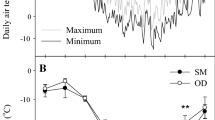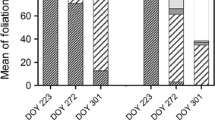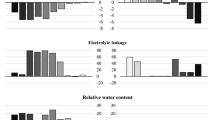Abstract
The annual changes in frost hardiness were studied for three Eucalyptus gunnii genotypes. Frost resistance evaluated on leaf discs by the electrolyte leakage method reached a maximum in the coldest period and a minimum in summer demonstrating winter frost hardening. Genotype 634 exhibited a higher intrinsic resistance than the other genotypes both in the hardened and in the non-hardened stages. Plants of this genotype were also frost acclimated in controlled conditions by a progressive decrease of culture temperature (25 to 0 °C) but the degree of hardening appeared to be lower in these conditions. The carbohydrate patterns in leaves varied with acclimation. In controlled conditions the leaves of genotype 634 exhibited a rise in sucrose, fructose and raffinose concentration up to a temperature of 10 to 7 °C which subsequently decreased. In natural conditions a comparison of the three genotypes allowed us to correlate the higher intrinsic resistance of genotype 634 to a higher soluble sugar content. During acclimation fructose and raffinose changes were also correlated to an increase in cold resistance even though the kinetics of these changes differed in controlled and natural conditions. The starch content was very low in the various genotypes in the different conditions but oligosaccharides such as stachyose and possibly verbascose were detected. The results point out the relationships occurring between increased frost resistance and changes in fructose and raffinose concentration in E. gunnii leaves.
Similar content being viewed by others
References
Almeida MH, Chaves MM, Silva JC (1994) Cold acclimation in eucalyptus hybrids. Tree Physiol 14: 921–932
Alberdi M, Meza-Basso L, Fernandez J, Rios D, Romero M (1989) Seasonal changes in carbohydrate content and frost resistance of leaves of Nothofagus species. Phytochemistry 28: 759–763
Anchordoguy TJ, Rudolph AS, Carpenter JF, Crowe JH (1987) Mode of interaction of cryoprotectants with membrane phospholipids during freezing. Cryobiology 24: 324–331
Battaglia M, Reid JB (1993) Ontogenetic variation in frost resistance of Eucalyptus delegatensis. Aust J Bot 41: 137–141
Bonicel A, Haddad G, Gagnaire J (1987) Seasonal variations of starch and major sugars in the different organs of young poplars. Plant Physiol Biochem 25: 451–459
Caffrey M, Fonseca V, Leopold AC (1988) Lipid-sugar interactions. Relevance to anhydrous biology. Plant Physiol 86: 754–758
Castillo EM, de Lumen BO, Reyes PS, de Lumen HZ (1990) Raffinose synthase and galactinol synthase in developing seeds and leaves of legumes. J Agric Food Chem 38: 351–355
Cauvin B (1988) Eucalyptus: les tests de résistance au froid. Annales de Recherches Sylvicoles. AFOCEL, Paris, pp 161–195
Eldridge KG (1969) Altitudinal variation in Eucalyptus regnans. Ph. D. thesis, Australian National University, Canberra
Fischer C, Höll W (1991) Food reserves of Scots pine (Pinus sylvestris L.). I. Seasonal changes in the carbohydrate and fat reserves of pine needles. Trees 5: 187–195
Graham D, Patterson BD (1982) Responses of plants to low non freezing temperatures: proteins, metabolism and acclimation. Annu Rev Plant Physiol 33: 347–372
Hallam PM, Reid JB (1988) Seasonal and genetic variation in frost hardiness of Eucalyptus delegatensis. Can J For Res 19: 480–488
Hallam PM, Tibbits WN (1988) Determination of frost hardiness of Eucalyptus using the electrical conductivity of diffusate in conjunction with a freezing chamber. Can J For Res 18: 595–600
Hinesley LE, Pharr DM, Snelling LK, Funderburk SR (1992) Foliar raffinose and sucrose in four conifer species: relationship to seasonal temperature. J Am Soc Hort Sci 117: 852–855
Jourdan J (1980) Variations saisonnières des teneurs en amidon et en sucres solubles dans de jeunes peuplier. Ann Afocel 1979: 201 -223
Kaurin A, Junttila O, Hansen J (1981) Seasonal changes in frost hardiness in cloudberry (Rubus chamaemorus) in relation to carbohydrate content with special reference to sucrose. Physiol Plant 52: 310–314
Koski V (1985) The timing of hardening and dehardening of forest trees. Acta Hort 168: 117–124
Koster KL, Lynch DV (1992) Solute accumulation and compartimentation during the cold acclimation of Puma rye. Plant Physiol 98: 108–113
Lasheen AM, Chaplin CE (1971) Biochemical comparison of seasonal variation in three peach cultivars differing in cold hardiness. J Am Soc Hort Sci 96: 154–159
Leborgne N, Teulières C, Travert S, Rols M-P, Teissié J, Boudet AM (1995) Introduction of specific carbohydrates into Eucalyptus gunnii cells increases their freezing tolerance. Eur J Biochem (in press)
Levitt J (1980) Response of plants to environmental stress, vol 1. Academic Press, New York
Paton DM (1982) A mechanism for frost resistance in Eucalyptus. In: Li PH, Sakai A (eds) Cold hardiness and freezing stress, vol 2. Academic Press, London, pp 77–92
Pomeroy MK, Siminovitch D (1970) Seasonal biochemical changes in the living bark and needles of red pine (Pinus resinosa) in relation to adaptation to freezing. Can J Bot 48: 953–967
Potts BM, Potts WC, Cauvin B (1987) Inbreeding and interspecific hybridation in E. gunnii. Silvae Genet 36: 543–562
Raymond CA, Harwood CE, Owen JV (1986) A conductivity method for screening populations of Eucalyptus for frost damage and frost tolerance. Aust J Bot 34: 377–393
Raymond CA, Owen JV, Ravenwood IC (1992) Genetic variation for frost tolerance in a breeding population of Eucalyptus nitens. Silvae Genet 41: 355–362
Ristic Z, Ashworth EN (1993) Changes in leaf ultrastructure and carbohydrates in Arabidopsis thaliana L. (Heyn) cv. Columbia during rapid cold acclimation. Protoplasma 172: 111–123
Rybka Z (1993) Changes in carbohydrate pool and osmolality in crowns and leaves of winter wheat seedlings during hardening to frost. Acta Physiol Plant 15: 47–55
Sakai A, Larcher W (1987) Frost survival of plants. Responses and adaptation to freezing stress. (Ecological studies, vol 62) Springer, Berlin Heidelberg New York
Santarius KA (1973) The protective effect of sugars on chloroplast membranes during temperature and water stress and its relationship to frost desiccation and heat resistance. Planta 113: 105–114
Sauter JJ, Kloth S (1987) Changes in carbohydrates and ultrastructure in xylem ray of Populus in response to chilling. Protoplasma 137: 45–55
Scarascia-Mugnozza G, Valentiny R, Kuzminski E, Giordano E (1989) Freezing mechanisms, acclimation processes and cold injury in Eucalyptus species planted in the mediterranean region. For Ecol Manage 29: 81–94
Stone JM, Palta JP, Bamberg JB, Weiss LS, Harbage JF (1993) Inheritance of freezing resistance in tuber-bearing Solatium species: evidence for independent genetic control of nonacclimated freezing tolerance and cold acclimation capacity. Proc Natl Acad Sci USA 90: 7891–7873
Stushnoff C, Remmele RL Jr, Essensee V, McNeil M (1993) Low temperature induced biochemical mechanisms: implications for cold acclimation and deacclimation. Interacting stresses on plants in a changing climate. NATO ASI Series I 16: 647–680
Teulières C, Feuillet C, Boudet AM (1989) Differential characteristics of cell suspension cultures initiated from Eucalyptus gunnii clones differing by their frost tolerance. Plant Cell Rep 8: 407–410
Tibbits WN, Reid JB (1987) Frost resistance in Eucalyptus nitens (Deane & Maiden) Maiden: physiological aspects of hardiness. Aust J Bot 35: 235–250
Tronsmo AM, Kobro G, Morgenlie S, Flengsrud R (1993) Carbohydrate content and glycosidase activities following cold hardening in two grass species. Physiol Plant 88: 689–695
Yelenoski G, Vu JCV (1992) Ability of “Valencia” sweet orange to cold-acclimate on cold-sensitive citron rootstock. Hort Science 27: 1201–1203
Author information
Authors and Affiliations
Rights and permissions
About this article
Cite this article
Leborgne, N., Teulières, C., Cauvin, B. et al. Carbohydrate content of Eucalyptus gunnii leaves along an annual cycle in the field and during induced frost-hardening in controlled conditions. Trees 10, 86–93 (1995). https://doi.org/10.1007/BF00192188
Received:
Accepted:
Issue Date:
DOI: https://doi.org/10.1007/BF00192188




